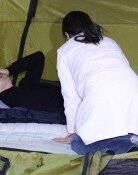Kids Smiles Are Part of Nature
Kids Smiles Are Part of Nature
Posted April. 04, 2007 07:55,
The North Branch School of Jisan Elementary School, located in Hyoryeong-dong, Buk-gu, Gwangju, is a cozy little school in an urban setting.
This school became a branch school two years ago because of the rapid fall in enrollment. Currently, there are 42 students and six teachers. Even though geographically it is included in the district of Gwangju, a large city with 1,400,000 people, it is as cozy as a small rural school as it is located on the outskirts of the city.
On March 29, they had a party with wormwood rice cakes that were made by the students parents. The school was filled with the air of delight.
Park Ji-suk, 37, mother of twins, Goh Hyeon-seo and Goh Eun-seo, students of this school, made the wormwood rice cakes.
By having this party, the twins also deserve credit. They picked a basket of wormwood growing along side of the school garden with their classmates.
Park said, My kids made the dough themselves and had great fun while making star-shaped and heart-shaped pieces of cake. She added, In other schools in urban areas, it is very rare to see such scene. However, it is not rare here.
This school is a part of nature. Passing through a nice little front gate, we soon meet fine tree gardens leading to a playground. Every spring, the school is surrounded by bright forsythias, and the gardens turn into a pink wave with colorful plants. Wild flowers such as pasqueflowers, dandelions, and iris are also abundant here.
The educational principle of this school is to let students play in nature and learn from it. Since most of the students dont go to private institutes, the school turns into a playground after the classes are over.
Kids jump around in class and have fun with each other while playing with the dirt from the kitchen garden or the playground. Thanks to them, the school is always filled with lively energy even after the end of classes.
There are only three after-school programs: a play, science research, and music. They are not compulsory.
Contrary to other elementary schools which operate 20 to 30 after-school programs, the school reduced the number of programs at the request of parents. This was done based on the belief that the best education is to let students do whatever they want and do it without stress.
Since 2005, the number of new students has increased because it has earned a reputation as a school in nature, providing a friendly environment for kids who suffer from skin problems such as atopy.
Last year, there were five new students, and this year the number increased to 11. Of those, five have skin problems.
Out of the entire student population, 13 students have skin problems, and their symptoms have remarkably improved with age.
Another special feature of this school is an ecological culture experience program that is conducted by parents.
Around the middle of May every year, students camp overnight in the school with their families and have an experience in nature such as observing wild flowers, star gazing, and grilling sweet potato over firewood.
They also hold a harvest festival in the autumn and have a party with parents and teachers while enjoying vegetables produced from the schools kitchen garden such as potatoes, beans, cabbages, and crown daisies.
During winter, students learn the importance of agriculture and protecting the environment while making scarecrows and ceramic wares, investigating the boggy grounds of Yeongsan River, and flying kites together with the residents of the Hyoryeong village. This program is so successful that students from other schools also participate.
Choi Yeong-seon, president of this branch and teacher of the first grade classes, said, Parents are very willing to infuse their kids with partnership as a member of the community and recognition about the importance of nature, adding, Since we have a small number of students, we have the advantage of teaching students in accordance with the level of their abilities.
shjung@donga.com




![“한동훈, 정치생명 걸고 무소속 출마해 평가받는 것 고려할만”[정치를 부탁해]](https://dimg.donga.com/c/138/175/90/1/wps/NEWS/IMAGE/2026/01/19/133186982.1.jpg)


